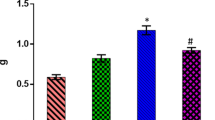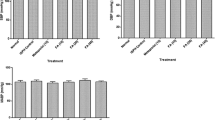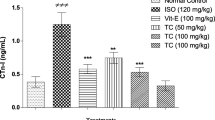Abstract
administration of isoproterenol to mice at a dose of 30 mg/100 g body weight for 3 consecutive days at an interval of 24 h induced lipid peroxidation in cardiac tissue and exhibited a significantly elevated serum glutamate oxaloacetate transaminase (SGOT) level. Increased superoxide dismutase (SOD) activity with a concomitant decrease in catalase activity has also been observed in cardiac tissue with isoproterenol treatment. Quinidine, a class I antiarrhythmic agent has been found to exhibit a protective role in isoproterenol induced myocardial ischaemia. Cardiac tissue of quinidine treated mice showed reduction of lipid peroxidation reaction. In addition, quinidine treatment is found to influence the cardiac antioxidant enzymes – catalase and SOD. The decrease of SOD activity and increase of catalase activity suggests that quinidine also exerts an ‘indirect antioxidant’ effect in protecting the myocardial tissue from reactive oxygen species. Furthermore, our current in vitro studies with quinidine have clearly shown in this work that it possesses a very convincing hydroxyl radical scavenging potential with almost no ability to scavenge superoxide anion and hydrogen peroxide (H2O2) in vitro. Thus, our present investigation suggests that quinidine, when administered to mice, strengthens the antioxidant defense system to resist the free radical induced damage brought about by isoproterenol induced ischaemic condition.
Similar content being viewed by others

References
Sies H (ed): Oxidative Stress. Academic Press, New York, 1985
Emerit I, Packer L (eds): Antioxidants in Therapy and Preventive Medicine. Plenum, New York, 1990
Bindoli A, Rigobella MP, Deeble DJ: Biochemical and toxicological properties of the oxidation products of catecholamines. Free Radic Biol Med 13: 391-405, 1992
Stelzner TJ, Welsh CH, Berger E, McCullough RG, Morris K, Repine JE, Weil JV: Antiarrhythmic agents diminish thiourea-induced pulmonary vascular protein leak in rats. J Appl Physiol 63: 1877-1883, 1987
Biemond P, van Eÿk HG, Swaak AJG, Koster JF: Iron mobilization from ferritin by superoxide derived from stimulated polymorphonuclear leukocytes. Possible mechanism in inflammation diseases. J Clin Invest 73: 1576-1579, 1984
Biemond P, Swaak AJ, Beindorff CM, Koster JF: Superoxide dependant and independent mechanisms of iron mobilization from ferritin by xanthine oxidase. Implications for oxygen-free-radical induced tissue destruction during ischaemia and inflammation. Biochem J 239: 169-173, 1986
Rubanyi GM, Vanhoutte PM: Oxygen-derived free radicals, endothelium, and responsiveness of vascular smooth muscle. Am J Physiol 250: H815-H821, 1986
McCord JM, Day ED Jr: Superoxide-dependant production of hydroxyl radical catalyzed by iron-EDTA complex. FEBS Lett 86: 139-142, 1978
Halliwell B, Gutteridge JM: The importance of free radicals and catalytic metal ions in human diseases. Mol Aspects Med 8: 89-193, 1985
Nelson SK, Bose SK, McCord JM: The toxicity of high-dose superoxide dismutase suggests that superoxide can both initiate and terminate lipid peroxidation in the reperfused heart. Free Radic Biol Med 16: 195-200, 1994
Braughler JM, Pregenzer JF, Chase RL, Duncan LA, Jacobson EJ, McCall JM: Novel 21-amino steroids as potent inhibitors of iron-dependant lipid peroxidation. J Biol Chem 262: 10438-10440, 1987
Halliwell B, Gutteridge JMC: Oxygen free radicals and iron in relation to biology and medicine: Some problems and concepts. Arch Biochem Biophys 246: 501-514, 1986
Das KC, Misra HP: Antiarrhythmic agents — scavengers of hydroxyl radicals and inhibitors of NADPH-dependant lipid peroxidation in bovine lung microsomes. J Biol Chem 267: 19172-19178, 1992
Martin JP, Dailey M, Sugarman E: Negative and positive assays of superoxide dismutase based on hematoxylin autooxidation. Arch Biochem Biophys 255: 329-326, 1987
Beers RF Jr, Sizer IW: A spectrophotometric method for measuring the breakdown of hydrogen peroxide by catalase. J Biol Chem 195: 133-140, 1952
Oshino N, Chance B, Sies H, Bucher T: The role of H2O2 generation in perfused rat liver and the reaction of catalase compound I and hydrogen donors. Arch Biochem Biophys 154: 117-131, 1973
Buege J A, Aust SD: Microsomal lipid peroxidation. Meth Enzymol 52: 302-310, 1978
Babbs CF, Steiner MG: Detection and quantitation of hydroxyl radical using dimethylsulfoxide as a molecular probe. Meth Enzymol 186: 137-147, 1990
Halliwell B, Gutteridge JMC, Aruoma OI: The deoxyribose method: A simple ‘test tube’ assay for determination of rate constants for reactions of hydroxyl radicals. Anal Biochem 165: 215-219, 1987
Misra HP, Fridovich I: The role of superoxide anion in the autooxidation of epinephrine and a simple assay for superoxide dismutase. J Biol Chem 247: 3170-3175, 1972
Bradford MM: A rapid and sensitive method for the quantitation of microgram quantities of protein utilizing the principle of protein-dye binding. Anal Biochem 72: 248-254, 1976
Murad N, Tucci PJ: Isoproterenol-induced hypertrophy may result in distinct left ventricular changes. Clin Exp Pharmacol Physiol 27: 352-357, 2000
Nirmala C, Puvanakrishnan R: Protective role of curcumin against isoproterenol induced myocardial infarction in rats. Mol Cell Biochem 159: 85-93, 1996
Sumitra M, Manikandan P, Kumar DA, Arutselvan N, Balakrishna K, Manohar BM, Puvanakrishnan R: Experimental myocardial necrosis in rats: Role of arjunolic acid on platelet aggregation, coagulation and antioxidant status. Mol Cell Biochem 224: 135-142, 2001
Tipnis UR, He GY, Li S, Campbell G, Boor PJ: Attenuation of isoproterenol-induced myocardial injury in rat by an inhibitor of polyamine synthesis. Cardiovase Pathol 9: 273-280, 2000
Preedy VR, Patel VB, Reilly ME, Richardson PJ, Falkous G, Mantle D: Oxidants, antioxidants and alcohol: Implications for skeletal and cardiac muscle. Frontiers in Bioscience 4: 58-66, 1999
Mousa SA, Patil G, Mayo MC, Tong M: Myocardial anti-ischemic characteristics of a novel class of beta-adrenoceptor blockers. Int J Clin Pharmacol Ther Toxicol 30: 103-106, 1992
Rathore N, Kale M, John S, Bhatnagar D: Lipid peroxidation and antioxidant enzymes in isoproterenol induced oxidative stress in rat erythrocytes. Ind J Physiol Pharmacol 44: 161-166, 2000
Singal PK, Kapur N, Dhillon KS, Beamish RE, Dhalla NS: Role of free radicals in catecholamin-induced cardiomyopathy. Can J Physiol Pharmacol 60: 1390-1397, 1982
Segura-Aguilar J, Lind C: On the mechanism of the Mn2+ induced neurotoxicity of dopamine. Prevention of quinone-derived oxygen toxicity of DT-diaphorase and superoxide dismutase. Chem Biol Interact 72: 309-324, 1989
Chevion M, Jiang Y, Har-el R, Berenshetein E, Uretzky G, Kitrossky N: Copper and iron are mobilized following myocardial ischaemia. Possible predictive criteria for tissue injury. Proc Natl Acad Sci USA 90: 1102-1106, 1993
Remiao F, Carmo H, Carvallo FD, Bastos ML: Inhibition of glutathione reductase by isoproterenol oxidation production. J Enzyme Inhib 15: 47-61, 2000
Vasil'ev AP, Strel'tsova NN, Gorbunova TI, Mal'tseva IA, Zykova EL: Antioxidant and antiarrythmic activity of carvedilol in patients with ischemic heart disease. Comparison with anaprilin. Ter Arkh 73: 65-67, 2001
Gao F, Chen J, Lopez BL, Christopher TA, Gu J, Lysko P, Ruffolo RR Jr, Ohlstein EH, Ma XL, Yu TL: Comparison of bisoprolol and carvedilol cardioprotection in rabbit ischemia and reperfusion model. Eur J Pharmacol 406: 109-116, 2000
Lysko PG, Webb CL, Gu JL, Ohlstein EH, Ruffolo RR Jr, Yue TL: A comparison of carvedilol and metoprolol antioxidant activities in vitro. J Cardiovasc Pharmacol 36: 277-281, 2000
Theres H, Wagner KD, Schulz S, Strube S, Leiterer KP, Romberg D, Gunther J, Scholz H, Bauman G, Schimke I: Oxygen radical system in chronic infracted rat heart: The effect of combined beta blockade and ACE inhibition. J Cardiovasc Pharmacol 35: 708-715, 2000
Chen Z, Siu B, Ho YS, Vincent R, Chua CC, Hamdy RC, Chua BHL: Overexpression of MnSOD protects against myocardial ischaemia/reperfusion injury in transgenic mice. J Mol Cell Cardiol 30: 2281-2289, 1998
Chen EP, Bittner HB, Davis RD, Tright PV, Folz RJ: Physiologic effects of extracellular superoxide dismutase transgene expression on myocardial function after ischaemia and reperfusion injury. J Thorac Cardiovasc Surg 115: 450-459, 1998
Chen Z, Oberley TD, Ho YS, Chua CC, Siu B, Hamdy RC, Epstein CJ, Chua BHL: Overexpression of CuZnSOD in coronary vascular cells attenuates myocardial ischaemia/reperfusion injury. Free Radic Biol Med 29: 589-596, 2000
Chance B: The primary and secondary compounds of catalase and methyl or ethyl hydroperoxide. J Biol Chem 179: 1341-1369, 1949
Das D, Bandyopadhyay D, Bhattacharjee M, Banerjee RK: Hydroxyl radical is the major causative factor in stress-induced gastric ulceration. Free Radic Biol Med 23: 8-18, 1997
Das D, Bandyopadhyay D, Banerjee RK: Oxidative inactivation of gastric peroxidase by site-specific generation of hydroxyl radical and its role in stress-induced gastric ulceration. Free Radic Biol Med 24: 460-469, 1998
Thomas Bigger JJ, Hoffman BF: Antiarrhythmic drugs. In: A. Goodman Gilman, L.S. Goodman, A. Gilman (eds). The Pharmacological Basis of Therapeutics. Macmillan Publishing Co. Inc., New York, 1980, pp 761-792
Tan DX, Manchester LC, Reiter RJ, Kim WQSJ, El-Sokkary GH: Ischaemia/reperfusion-induced arrhythmias in the isolated rat heart: Prevention by melatonin. J Pineal Res 25: 184-191, 1998
Author information
Authors and Affiliations
Rights and permissions
About this article
Cite this article
Chattopadhyay, A., Biswas, S., Bandyopadhyay, D. et al. Effect of isoproterenol on lipid peroxidation and antioxidant enzymes of myocardial tissue of mice and protection by quinidine. Mol Cell Biochem 245, 43–49 (2003). https://doi.org/10.1023/A:1022808224917
Issue Date:
DOI: https://doi.org/10.1023/A:1022808224917



